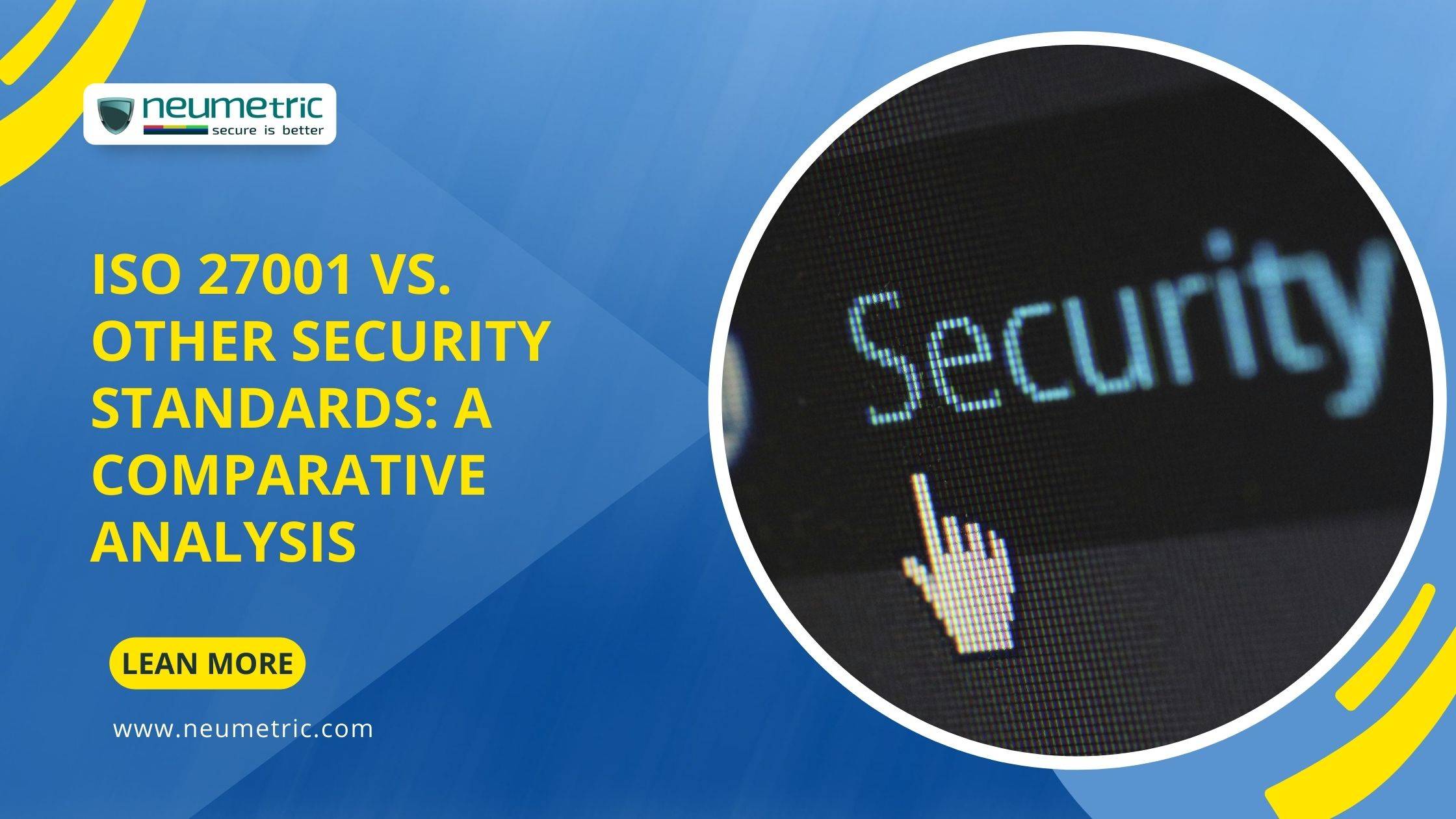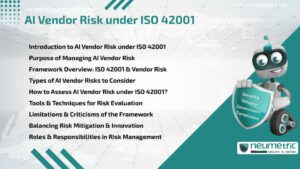Table of Contents
ToggleIntroduction
As cyber threats become ever more sophisticated, organisations are recognizing the need to implement robust information security controls & practices. This has led to a proliferation of security standards & frameworks, with ISO 27001 emerging as one of the most widely adopted international standards for managing sensitive information.
In this article, we will examine ISO 27001 in greater depth, understand how it compares to other prominent security standards & highlight the pros & cons of obtaining ISO 27001 certification.
What is ISO 27001?
ISO 27001 is an information security standard published by the International Organization for Standardization [ISO] & the International Electrotechnical Commission [IEC]. It outlines requirements for establishing, implementing, maintaining & continually improving an Information Security Management System [ISMS].
The core principle behind ISO 27001 is that organisations should systematically assess risks to their information assets & then design & implement a comprehensive set of information security policies, controls, procedures & technologies to address those risks.
Key Components of ISO 27001
Some key components of the ISO 27001 standard include:
- Information Security Policies: Formally documented policies approved by management that govern the security of information assets.
- Risk Assessment: A structured process that identifies information security threats, assesses the potential impacts of these threats & the likelihood that they will occur. This process is used to identify appropriate risk treatment measures.
- Risk Treatment: Selection & implementation of security controls & other measures to reduce information security risks to acceptable levels.
- Information Security Controls: Administrative, technical, physical & other controls to mitigate information security risks. ISO 27001 does not mandate specific controls, allowing organisations to choose what fits their unique risk environment.
- Management Commitment: Strong involvement & commitment from leadership is required for successful implementation of an ISMS.
- Training & Awareness: Educating employees on information security policies & ensuring they have the knowledge to fulfil their security obligations.
- Audits: Regular internal & external audits of the ISMS to identify non-conformities, opportunities for improvement & to validate that the system continues to meet requirements.
Other Widely Used Security Standards
While ISO 27001 takes a broad approach to managing organisational information security holistically, there are a number of other standards & frameworks that share a similar goal of improving security, but with some key differences.
- PCI DSS
The Payment Card Industry Data Security Standard [PCI DSS] was created by a consortium of credit card companies to provide a baseline of security controls for any entity that processes, stores or transmits payment card data. It comprises over two hundred (200) required controls that are organised into six (6) high level control objectives.
Some key requirements include:
- Building & maintaining secure networks
- Protecting cardholder data
- Maintaining a vulnerability management program
- Implementing strong access control measures
- Regular monitoring & testing of security systems
Unlike ISO 27001, the PCI DSS takes a very prescriptive approach in detailing the exact security controls that must be implemented by certified organisations.
- HIPAA Security Rule
The Health Insurance Portability & Accountability Act [HIPAA] Security Rule outlines mandatory information security standards for organisations that handle Protected Health Information [PHI]. It requires covered entities to implement physical, network & process security measures to ensure the confidentiality, integrity & availability of electronic health records.
Some major requirements include:
- Conducting risk analyses to identify threats to PHI & vulnerabilities
- Implementing administrative, physical & technical safeguards to mitigate risks
- Using encryption to secure PHI during storage & transmission
- Having procedures for security incident detection, response & reporting
The HIPAA Security Rule is focused specifically on regulating the healthcare industry’s management of personal medical data through technology.
- NIST Cybersecurity Framework
Developed by the National Institute of Standards & Technology [NIST], this framework provides voluntary cybersecurity guidance for U.S. critical infrastructure organisations. It encourages organisations to leverage existing standards, guidelines & practices to manage cybersecurity risks.
The framework has three key components:
- The Framework Core – a set of cybersecurity activities & references that are common across sectors
- The Framework Profile – organisations can use this to establish a roadmap of their current & desired cybersecurity posture
- The Framework Implementation Tiers – provides context on how an organisation views cybersecurity risk & the processes in place to manage it
The NIST framework is designed to complement rather than replace current cybersecurity programs & standards. It emphasises using business drivers to guide cybersecurity activities & adopting a cost-effective, risk-based approach.
- COBIT Framework
Control Objectives for Information & Related Technologies [COBIT] provides guidance on IT governance & control practices. Developed by Information Systems Audit & Control Association [ISACA], COBIT maps IT business requirements to IT resources, providing metrics & maturity models to measure whether the business objectives are being met.
The framework covers a comprehensive set of best practices & enablers clustered into five domains:
- Aligning IT strategy with business goals
- Building, acquiring & implementing technology solutions
- Delivering, servicing & supporting IT services
- Monitoring, evaluating & assessing IT performance
- Protecting information, data & technology infrastructure
For each of these domains, COBIT defines relevant control objectives, offers metrics to measure achievement & assess maturity through capability assessments.
Comparative Analysis of ISO 27001 & Other Standards
While all these standards & frameworks aim to improve information security management, there are some notable differences between ISO 27001 & these other commonly used standards.
- Scope & Focus
ISO 27001 takes a holistic approach, providing a complete Information Security Management System that can be applied to any organisation in any industry. Other standards like PCI DSS & HIPAA have a more limited scope, focusing on specific business sectors & compliance objectives.
- Risk Management Orientation
ISO 27001 mandates performing in-depth risk assessments & then selecting context-specific controls to mitigate risks to acceptable levels. In contrast, PCI DSS & HIPAA prescribe a common set of controls that all covered entities must implement, regardless of their risk profile.
- Flexibility vs. Prescriptiveness
ISO 27001 provides a high-level set of requirements that organisations can implement in a customised way based on their unique circumstances. NIST & COBIT also offer flexible frameworks. PCI DSS & HIPAA take a more prescriptive approach by listing the exact security measures organisations must put in place.
- Internal Audits
ISO 27001 requires both internal & external audits of the ISMS to maintain certification. PCI DSS involves annual external assessments but does not require formal internal audits. HIPAA does not mandate any specific audit frequency.
- Certification
ISO 27001 certification involves formal audits by accredited third-party certification bodies, resulting in an organisation obtaining certified status. There is no formal certification for NIST or COBIT, which offer voluntary guidelines. PCI DSS involves assessments resulting in compliance validation. HIPAA involves occasional audits to validate compliance rather than formal certification.
- Cost Considerations
ISO 27001 certification has moderate costs associated with building an ISMS, engaging consultants & conducting certification audits. HIPAA & PCI DSS compliance tend to have lower direct costs, with more reliance on leveraging internal resources. NIST & COBIT provide free guidance with no mandated assessments.
Pros & Cons of ISO 27001 Certification
ISO 27001 certification offers some valuable benefits:
- It provides an independent, expert validation that your ISMS meets international best practices for information security.
- Certification enhances your reputation as a trusted entity that values security.
- Adopting ISO 27001 demonstrates diligence & can provide a competitive edge.
- The comprehensive, risk-based approach promotes tight alignment between security & broader business objectives.
- Certification shows commitment to continuous improvement in information security.
However, there are also some downsides to weigh:
- Attaining & maintaining certification requires a significant investment of time & resources. The costs, effort & process changes can be substantial.
- Much time is spent on document creation, review cycles & other administrative tasks to satisfy certification requirements.
- The technical controls required for certification may increase operating costs & overhead.
- After a few years of inflated IT budgets to enable & sustain certification, some organisations question the return on investment.
- The focus on compliance can sometimes overshadow operational priorities & staff may view ISO 27001 as a burden.
Before undertaking ISO 27001 certification, organisations should carefully consider if they are ready to commit the required resources on an ongoing basis. While ISO 27001 adoption provides benefits, it may not be the best fit for companies just looking for a limited focus on certain compliance requirements or security quick wins.
Conclusion
While various security standards & frameworks have their own strengths & applications, ISO 27001 stands out as one of the most rigorously defined international standards for holistic information security management. It takes a risk-based approach that aligns security with overall business objectives.
However, ISO 27001 also involves significant effort & cost to implement, gain certification & maintain ongoing compliance. Organisations should weigh the pros & cons to determine if ISO 27001 is the right fit as opposed to more targeted standards like PCI DSS & HIPAA.
Regardless of the standards adopted, continuous improvement in information security & data protection practices is crucial for every modern enterprise. As cyber threats evolve, both technology & humans need to adapt to counter these challenges. A combination of vigilance, proper governance, smart systems & a culture of security provides the best foundation for tackling information risks.
FAQ
- What are some key differences between ISO 27001 & industry-specific standards like PCI DSS & HIPAA?
The main differences are that ISO 27001 takes a broader, more flexible & risk-based approach to managing organisational information security. It offers a comprehensive framework that can apply to any industry. Standards like PCI DSS & HIPAA are more limited in scope, focusing on specific compliance objectives for the credit card & healthcare sectors respectively. They also tend to be more prescriptive in detailing required security controls. ISO 27001 does not prescribe specific controls, allowing companies to choose those that are appropriate for their unique risk environment & business needs.
- Does implementing ISO 27001 require significant resource investment?
Yes, attaining & maintaining ISO 27001 certification demands substantial time, effort & budget. Creating the detailed documentation required, implementing controls across the organisation, conducting regular audits & driving an ongoing certification & continual improvement process involves considerable overhead. Many companies find that while ISO 27001 adoption provides valuable security improvements, it also results in large investments that should be carefully evaluated from a cost-benefit perspective over a multi-year timeline.
- Can organisations use ISO 27001 in conjunction with other security standards?
Absolutely. ISO 27001 is designed to be comprehensive but flexible. It provides overarching information security management guidelines that can be integrated quite well with more specific standards & controls. For example, companies in the payment card industry can use ISO 27001 as an overall information security framework, while also adhering to the detailed control requirements prescribed by the PCI DSS. Healthcare organisations can leverage ISO 27001 for their holistic security strategy while ensuring they comply with all HIPAA regulations. ISO 27001 even references other accepted security standards & controls within its guidance. Adopting a well-rounded approach using ISO 27001 in conjunction with other relevant standards can be an effective strategy for many organisations.





